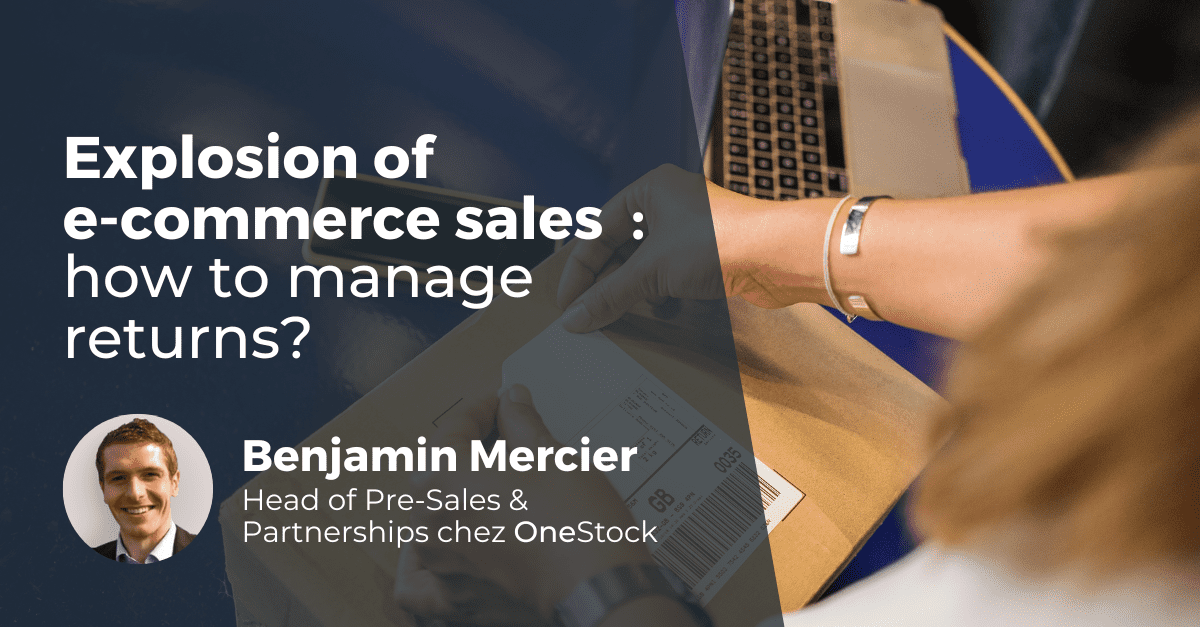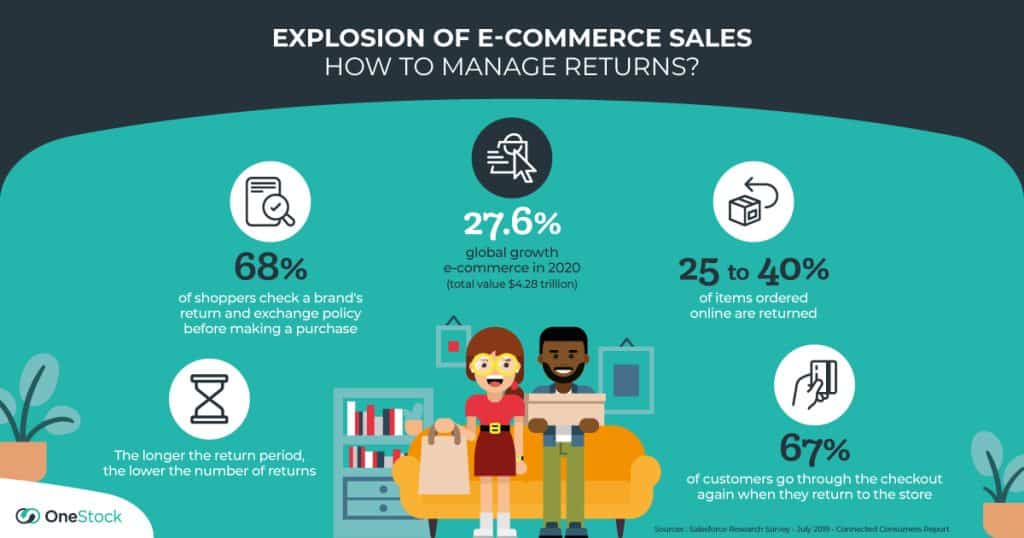
As e-commerce sales explode, how can retailers manage returns?
With global growth of 27.6% in 2020, for a total of $4,280 billion, e-commerce is a sales channel that continues to expand. But the growth in online shopping is also leading to an increase in the number of returns made by customers.
More than ever, allocating time and resources to the management of customer returns is a competitive issue. Faced with numerous return methods and varying deadlines, we can legitimately ask ourselves how to set up reassuring return processes for customers.

Clear returns policy
The first step, which should not be overlooked, is posting a simple and precise returns policy. As UPS reports, 68% of shoppers check a brand’s return and exchange policy before making a purchase. The challenge is to specify the conditions that need to be met for a return to be accepted by the brand whilst keeping customer satisfaction in mind. Must be listed, for example, statements about:
- The condition of the products: the presence of labels, original packaging, …
- The deadline under which the items must be returned: 10, 15, 30, 45 days? An interesting fact to take into account: a study from the University of Texas shows that the longer the return period, the lower the number of returns.
- The pricing policy: return at the customer’s expense, return at the retailer’s expense, return paid in advance by the customer then reimbursed by the brand, …
Any postal return made must lead to a follow-up in order to reassure the customer that the items have been received. The brand must give them the opportunity to follow the logistics path of his package and to be informed of the associated stages.
An unclear or overly restrictive returns policy will negatively impact your conversion rate and could lead to negative comments or ratings on search engines.
Multiplying returns channels
Whether the purchases are made online or in-store, it must be easy for customers to return unsatisfactory items. With, depending on the sector, 25 to 40% of items ordered online being returned, the return policy must be designed and integrated as an important element of the omnichannel offer.
The customer wants the return process to be easy, independently of the sales channel or delivery method. You must give them the opportunity to return an item delivered at home back to their local store or ship a return package for an item they collected or bought directly in-store.
To avoid waste, consider using returnable packaging, which can be reused by your customer to return their items.
Depending on the ordering method, 3 types of returns are generally offered to customers:
- Pre-printed return labels
To make the customer’s life easier, you can directly print and put a label and a return slip in each package sent to the customer. The return is simple and immediate!
The downsides are the unnecessary printing of this label for orders that will not be returned and the inability to make a pre-return declaration, which may be a concern for customers. In addition, the customer does not have information regarding where the package can be returned, nor can they return it to their letterbox. They will still have to go online to obtain that information.
- Self-service return request
When purchasing online, self-service returns requests allow customers to easily report a return and be guided through the process of preparing and shipping their return. The customer knows directly whether their items are returnable or not and under what price conditions. It is a more reassuring process for the client.
We offer the customer all possible return methods, with an interactive map: in pick-up & Go stores, post offices, letter boxes or even directly in-store. Returning to the postbox is very easy since the postman is automatically informed that he must pick up the parcel from the letterbox on the requested date (usually the next day).
Disadvantage: The customer usually needs to have a printer to print their return label, excepted if the carrier allows for unlabelled returns.
Whether deposited by the buyer, or withdrawn by the postman, once the package has been taken, customers are informed of each stage of its delivery: collection, receipt, processing, reimbursement.
- In-store returns
When a purchase is made and returned to the store, the sales receipt provides access to the information necessary to make the return.
In the context of a home delivery, Click and Collect or Reserve & Collect order, the salesperson’s tablet allows them to easily find information about the order (content, type, amounts), about the customer (contact details, order history) and report a return (returned items, reasons for the return, condition of the items). Once all this information has been verified, the salesperson prints, or sends via email the proof of return to be kept by the customer. The refund is immediate.
- Customer service’s returns
Following a web order, customers can directly contact customer service who will assist them in the entire return process: reasons for the return, sending the label to be printed…
The OMS to manage customers’ returns
The Order Management System and its orchestration module allow for optimised returns management. We are referring to Reverse Logistics: the OMS redistributes the products either to stores or to the warehouse according to criteria previously defined by the retailer. This intelligent reallocation of returned stock speeds up the relocation of items for sale. Returns can even be used to restock stores that are out of stock on specific items!
The OMS can also encourage returns in-store. Particularly if the reason given for the return concerns a sizing problem. If the desired size is present in a store near the customer, an in-store exchange will then be offered to the customer. The client can therefore decide to proceed with the exchange in store (where the new size will be reserved for them) or to continue their return process online. From a business point of view, returning to the store is an opportunity as it is estimated that 67% of customers go through the checkout again when they return to the store (71% for millennials).
Source: Salesforce Research Survey – July 2019 – Connected Consumers Report


